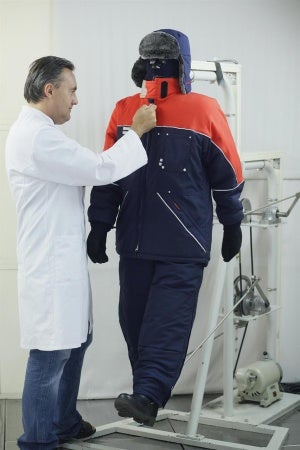
Scientists from the Hohenstein Institute in Bönnigheim have worked with the specialists in protective clothing at Tempex in Heidenheim to develop innovative solutions for cold protection clothing. The so-called full-protection systems, consisting of jacket and trousers, provide excellent thermal insulation at low temperatures, but are greatly reduced in weight.
In Germany alone, about 15,000 people work in low-temperature conditions in cold stores and refrigerated warehouses. Working for eight hours a day, throughout the year, at temperatures down to -28°C, is tough and exerts a physical strain on the employees.
In this kind of working environment, it is essential to wear high-performance cold protection clothing that is lightweight and therefore comfortable, but also provides excellent thermal insulation.
Being cold is not only uncomfortable, but over long periods can lead to a reduction in body temperature and damage to the health which may have various negative consequences. A slowing down in reaction speed and a loss of concentration can considerably increase the risk of accidents at work. The long-term consequences of exposure to cold include rheumatism and chronic illnesses of the respiratory tract, urinary organs and vascular system.
The considerable weight of protective clothing restricts the mobility of the wearer and leads to the formation of sweat, which can make it feel uncomfortable. Even at low temperatures, about 200g to 220g of sweat is produced every hour as a result of physical exertion.
Sweaty clothing smells unpleasant and considerably reduces the wearer’s feeling of well-being. More importantly, the sweat and condensation, which form on the cool outer surface of the clothing as a result of the difference in temperature, reduce the thermal insulation properties of protective clothing so that the body loses heat.
The weight of this newly developed cold protection suit, which consists of overalls and a jacket, has been reduced by 25% while retaining the same thermal insulation properties. Furthermore, the high breathability of the clothing, especially in parts of the body where there are a lot of sweat pores, such as on the chest, back, upper arms and armpits, means that the sweating rate is lower than with any competing product. The amount of sweat produced by volunteers in the trial was reduced by about 50% to less than 100g per hour.
This improvement over the old-style textile construction was achieved by using a special, washable insulating fleece. This fleece was incorporated into the clothing in one or more layers, depending on the part of the body, and in combination with other design elements. Using it in this variable and requirement-based way allowed the level of comfort for the wearer to be improved while maintaining the same good thermal insulation properties and air permeability.
As a result of the reduced weight, the modified thermal insulation and the improved breathability, the protective function and comfort of this new and innovative cold protection suit have been greatly increased.
The results achieved in the project will enable other innovative products to be developed to improve the well-being and comfort of the wearer and it is expected that there will be a great demand for them on the market.

